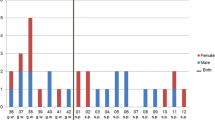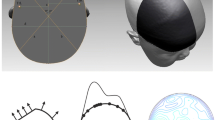Abstract
In this study, we aimed to reveal whether the medial longitudinal arch is formed in the intrauterine period and the structural features of the medial longitudinal arch. The study was conducted on 146 feet of 73 fetuses (38 male, 35 female) aged between 15 and 40 weeks of gestation. The fetuses were grouped by trimesters. The footprints taken were photographed with a millimeter ruler, and the development of the medial longitudinal arch was examined on footprints based on the Clarke index, Chipaux-Smirak index, and Staheli index. In Clarke index and Staheli index, it was observed that the arch height was normalized in the transition from the second trimester to the third trimester, the arch decreased in the transition to full-term, and the rate of pes planus increased. All indices detected pes planus by 81.81% in the full-term period. The rate of pes planus determined according to Clarke index and Staheli index, especially in the third trimester period, was 6.94% and 11.11%, respectively. We have provided a perspective on how the development of the medial longitudinal arch is shaped in the intrauterine period. Based on the results of study, we consider that the data on the medial longitudinal arch, especially in the third trimester period, may be more significant. In the evaluations made from the footprints of premature infants in the intrauterine third trimester period in the future, a study, in which infants detected with pes planus can be followed up and the development of their medial longitudinal arch is evaluated, can be conducted.


Similar content being viewed by others
References
Abdel-Fattah MM, Hassanin MM, Felembane FA, Nassaane MT (2006) Flat foot among Saudi Arabian army recruits: prevalence and risk factors. East Mediterr Heal J 12:211–217
Ashok A, Kulkarni M, Gandotra A (2017) Quantitative morphology of medial longitudinal arch among young Indian adults. Indian J Clin Anat Physiol 4:212–217
Atik A, Özyürek S (2014) Flexible flatfootness. North Clin Istanb 1:57–63
Carr JB, Yang S, Lather LA (2016) Pediatric pes planus: a stateofthe-art review. Pediatrics 137(3):e20151230
Chang JH, Wang SH, Kuo CL, Shen HC, Hong YW, Lin LC (2010) Prevalence of flexible flatfoot in Taiwanese school-aged children in relation to obesity, gender, and age. Eur J Pediatr 169:447–452
Chen JP, Chung MJ, Wang MJ (2009) Flatfoot prevalence and foot dimensions of 5- to 13-year-old children in Taiwan. Foot Ankle Int 30:326–332
Chen KC, Yeh CJ, Kuo JF, Hsieh CL, Yang SF, Wang CH (2011) Footprint analysis of flatfoot in preschool-aged children. Eur J Pediatr 170:611–617
Chippaux C (1948) École d’application du Service de santé des troupes coloniales. Elem d’anthropologie. Published online 1948
Clarke HH (1933) An objective method of measuring the height of the longitudinal arch in foot examinations. Res Q Am Phys Educ Assoc 4:99–107
Dunn JE, Link CL, Felson DT, Crincoli MG, Keysor JJ, McKinlay JB (2004) Prevalence of food and ankle conditions in a multiethnic community sample of older adults. Am J Epidemiol 159:491–498
García-Rodríguez A, Martín-Jiménez F, Carnero-Varo M, Gómez-Gracia E, Gómez-Aracena J, Fernández-Crehuet J (1999) Flexible flat feet in children: a real problem? Pediatrics 103(6):e84
Giannini S (1998) Operative treatment of the flatfoot: why and how. Foot ankle Int 19:52–56
Gore AI, Spencer JP (2004) The Newborn Foot. Am Fam Physician 69:865–872
Gruber H, Brenner E, Schmitt O, Fritsch H (2001) The different growth zones of the fetal foot. Ann Anat 183(3):267–274
Jane MacKenzie A, Rome K, Evans AM (2012) The efficacy of nonsurgical interventions for pediatric flexible flat foot: a critical review. J Pediatr Orthop 32:830–834
Kanatli U, Yetkin H, Cila E (2001) Footprint and radiographic analysis of the feet. J Pediatr Orthop 21:225–228
Kosashvili Y, Fridman T, Backstein D, Safir O, Ziv YB (2008) The correlation between pes planus and anterior knee or intermittent low back pain. Foot Ankle Int 29:910–913
Lakstein D, Fridman T, Ziv YB, Kosashvili Y (2010) Prevalence of anterior knee pain and pes planus in israel defense force recruits. Mil Med 175:855–857
Levy JC, Mizel MS, Wilson LS et al (2006) Incidence of foot and ankle injuries in west point cadets with pes planus compared to the general cadet population. Foot Ankle Int 27:1060–1064
Lin CJ, Lai KA, Kuan TS, Chou YL (2001) Correlating factors and clinical significance of flexible flatfoot in preschool children. J Pediatr Orthop 21:378–382
Malas MA, Desdicioglu K, Cankara N, Evcil EH, Özgüner G (2007) Fetal dönemde fetal yasın belirlenmesi (In English; Determination of fetal age during the fetal period). Med J Suleyman Demirel Univ 14:20–24
Mosca VSMD (2001) The cavus foot. J Pediatr Orthop 21:423–424
Nikolaidou ME, Boudolos KD (2006) A footprint-based approach for the rational classification of foot types in young schoolchildren. Foot 16:82–90
Onodera AN, Sacco ICN, Morioka EH, Souza PS, de Sá MR, Amadio AC (2008) What is the best method for child longitudinal plantar arch assessment and when does arch maturation occur? Foot 18:142–149
Pfeiffer M, Kotz R, Ledl T, Hauser G, Sluga M (2006) Prevalence of flat foot in preschool-aged children. Pediatrics 118:634–639
Queen RM, Mall NA, Hardaker WM, Nunley JA (2007) Describing the medial longitudinal arch using footprint indices and a clinical grading system. Foot Ankle Int 28:456–462
Sahin O, Arican G, Özmeriç A, Alemdaroglu KB (2018) 18–22 yaş araliği erkeklerde pes planus prevalansi : kesitsel çalişma (In English; The prevalence of pes planus in males between the ages of 18–22: cross-sectional study). Ankara Egt Arş Hast Derg 51(3):206–210
Shih YF, Chen CY, Chen WY, Lin HC (2012) Lower extremity kinematics in children with and without flexible flatfoot: a comparative study. BMC Musculoskelet Disord 13:1–9
Staheli LT (2006) Practice of pediatric orthopedics. Lippincott Williams & Wilkins, Philadelphia
Staheli LT, DE Chew CM (1987) The longitudinal arch. A survey of eight hundred and eighty-two feet in normal children and adults. J Bone Jt Surg Am 69:426–428
Tenenbaum S, Hershkovich O, Gordon B et al (2013) Flexible pes planus in adolescents: body mass index, body height, and gender-an epidemiological study. Foot Ankle Int 34:811–817
Villarroya MA, Esquivel JM, Tomás C, Moreno LA, Buenafé A, Bueno G (2009) Assessment of the medial longitudinal arch in children and adolescents with obesity: footprints and radiographic study. Eur J Pediatr 168:559–567
Vittore D, Patella V, Petrera M et al (2009) Extensor deficiency: first cause of childhood flexible flat foot. Orthopedics 32:1–5
Wearing SC, Hills AP, Byrne NM, Hennig EM, McDonald M (2004) The arch index: a measure of flat or fat feet? Foot Ankle Int 25:575–581
Wenger DR, Mauldin D, Speck G, Morgan D, Lieber RL (1989) Corrective shoes and inserts as treatment for flexible flatfoot in infants and children. J Bone Jt Surg Ser A 71:800–810
Yalçin N, Esen E, Kanatli U, Yetkin H (2010) Evaluation of the medial longitudinal arch: a comparison between the dynamic plantar pressure measurement system and radiographic analysis. Acta Orthop Traumatol Turc 44:241–245
Acknowledgements
We thank Professor Soner Albay for his contributions.
Funding
This research received no specific grant from any funding agency in the public, commercial, or not-for-profit sectors.
Author information
Authors and Affiliations
Contributions
All authors contributed to the study conception and design. Material preparation, data collection and analysis were performed by AEC, KO, YK and AD. The first draft of the manuscript was written by AEC and all authors commented on previous versions of the manuscript. All authors read and approved the final manuscript.
Corresponding author
Ethics declarations
Conflict of interest
The authors declare that they have no conflict of interest.
Ethical approval
Approval was obtained from the Clinical Research Ethics Committee of Suleyman Demirel University, Faculty of Medicine, for this study (Date: 03.05.2019, Decision No: 86).
Additional information
Publisher's Note
Springer Nature remains neutral with regard to jurisdictional claims in published maps and institutional affiliations.
Supplementary Information
Below is the link to the electronic supplementary material.
Rights and permissions
About this article
Cite this article
Canbaloglu, A.E., Ozturk, K., Kastamoni, Y. et al. The development of the medial longitudinal arch in the intrauterine period. Anat Sci Int 96, 443–449 (2021). https://doi.org/10.1007/s12565-021-00610-1
Received:
Accepted:
Published:
Issue Date:
DOI: https://doi.org/10.1007/s12565-021-00610-1




